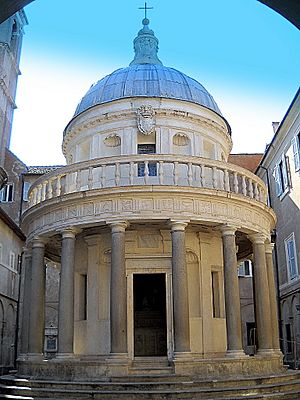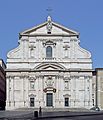Renaissance architecture facts for kids


Renaissance architecture is the European architecture of the period between the early 14th and early 16th centuries in different regions, demonstrating a conscious revival and development of certain elements of ancient Greek and Roman thought and material culture. Stylistically, Renaissance architecture followed Gothic architecture and was succeeded by Baroque architecture. Developed first in Florence, with Filippo Brunelleschi as one of its innovators, the Renaissance style quickly spread to other Italian cities. The style was carried to France, Germany, England, Russia and other parts of Europe at different dates and with varying degrees of impact.
Renaissance style places emphasis on symmetry, proportion, geometry and the regularity of parts, as they are demonstrated in the architecture of classical antiquity and in particular ancient Roman architecture, of which many examples remained. Orderly arrangements of columns, pilasters and lintels, as well as the use of semicircular arches, hemispherical domes, niches and aedicula replaced the more complex proportional systems and irregular profiles of medieval buildings.
The Dome of Florence Cathedral
- Florence Cathedral, (called il Duomo), built by Arnolfo di Cambio, had a huge hole at the centre. The competition to build a roof over it was won by Brunelleschi who built the largest dome since Roman times. He cleverly got the whole city excited by getting teams of workers from the eight parts of the city.
- Church of San Lorenzo
- This church in Florence was designed by Brunelleschi using all the things he had learnt by looking at the architecture of Ancient Rome. It has arches, columns and round-topped windows in the Roman style. It looks completely different to the pointy-arched churches of the Middle Ages. Only the inside was finished. The outside is still all rough bricks and no-on knows exacly how it was meant to look. On the inside, however, Brunelleschi taught everyone a new set of architectural rule that revolutionised The Renaissance.
- Church of Sant' Andrea
- When the Ancient Roman Emperors came back from winning a battle, they built a Triumphal Arch as a monument to themself. There are several of these monuments in Rome and they have the same design: a big arch at the centre, and a smaller lower arch or doorway on either side. The architect Alberti used this as the design for the front of the church of Sant' Andrea in Mantua. He used the same pattern of tall and arched, low and square, all down the inside of the church as well. This was copied by many other architects.
- Medici-Riccardi Palace
- When it came to building palaces, the rich people of the Renaissance had different needs to the Roman Emperors, so the architects had to use the rules to make a new sort of grand building. These Renaissance palaces are usually three stories high and quite plain on the outside. On the inside there is a courtyard, surrounded by beautiful columns and windows. Architects like Michelozzo who worked for Cosimo de' Medici, looked at the Roman Colisseum (sports arena) which is three stories high with rows of arches.
- https://commons.wikimedia.org/wiki/File:Florence_Medici_Riccardi_Palace.jpg
- Saint Peter's Basilica
- The most famous church in Rome was the ancient Church that had been built over the grave of St. Peter. By 1500 it was falling down. The Pope decided that instead of repairing it, it should be pulled down and a brand new church should be built. By the time it was finished, lots of important artists had worked on the design including Michelangelo, Raphael, Bramante, Maderna and Sangallo. It was the first building to use huge columns called a "giant order". It has one of the most magnificent domes in the world. It has been copied in many countries.
- Villa Rotunda
This country house was built by Palladio in 1550. It is a square building which looks the same from every side. At the centre, there is a dome. On every side is a large porch, (portico), like a Greek temple. It is such an elegant design that other architects used the same style which can be seen on churches, houses and palaces, including the White House.
Images for kids
-
The Romanesque Florence Baptistery was the object of Brunelleschi's studies of perspective
-
Pope Sixtus IV, 1477, builder of the Sistine Chapel. Fresco by Melozzo da Forlì in the Vatican Palace.
-
Four Humanist philosophers under the patronage of the Medici: Marsilio Ficino, Cristoforo Landino, Angelo Poliziano and Demetrius Chalcondyles. Fresco by Domenico Ghirlandaio.
-
Cosimo de' Medici the Elder, head of the Medici Bank, sponsored civic building programs. Posthumous portrait by Pontormo.
-
Scuola Grande di San Marco, Venice
-
The dome of Florence Cathedral (the Basilica di Santa Maria del Fiore)
-
The Palazzo Farnese, Rome (1534–1545). Designed by Sangallo and Michelangelo.
-
The House of the Blackheads in Riga, Latvia
-
Royal Summer Palace in Prague is considered the purest Renaissance architecture outside of Italy.
-
English Renaissance: Hardwick Hall (1590–1597).
-
Cloister of the Convent of Christ, Tomar, Portugal, (1557–1591), Diogo de Torralva and Filippo Terzi.
-
The Palace of Facets on the Cathedral Square of the Moscow Kremlin.
-
The Escorial (1563–1584), Madrid
-
The large Basilica of San Francisco in Quito, built between 1535 and 1650, a UNESCO World Heritage Site city.
See also
 In Spanish: Arquitectura del Renacimiento para niños
In Spanish: Arquitectura del Renacimiento para niños










































